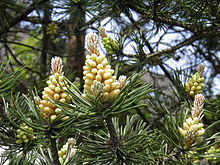Pine moth
| Pine moth | ||||||||||||
|---|---|---|---|---|---|---|---|---|---|---|---|---|

Pine moth ( Eupithecia indigata ) |
||||||||||||
| Systematics | ||||||||||||
|
||||||||||||
| Scientific name | ||||||||||||
| Eupithecia indigata | ||||||||||||
| ( Huebner , 1813) |
The pine moth ( Eupithecia indigata ) is a butterfly ( moth ) from the family of the spanners (Geometridae). The specific epithet is based on the Latin word indigus with the meaning "needy" and refers to the inconspicuous drawing and coloring of the moths.
features
butterfly
The wingspan of the moth is 15 to 21 millimeters. They are characterized by a slim and pointed wing shape. The basic color of all wings is essentially ash gray. Except for an elongated black discoid spot , they are almost without drawings. The transverse lines are sometimes slightly darkened. The fringes are not or only weakly piebald. The abdomen is colored gray and shows some short tufts of black hair.
Caterpillar, pupa
Adult caterpillars are smooth and very slender. They are colored ocher or reddish brown and show a light reddish brown top line and yellowish side stripes. The back of the head and the anus are dark brown. The light brown doll is provided with dark brown wing sheaths. There are eight hooked bristles of equal length on the cremaster .
Similar species
The somewhat smaller mountain spruce dwarf moth ( Eupithecia conterminata ) differs through a larger discoidal spot . A genital morphological examination is indicated for a reliable determination .
Distribution and occurrence
The distribution of the species extends from Spain through western and central Europe including the British Isles and further east to Kazakhstan , Russia and the Altai . In the north the area extends to the northern Fennoscandinavia beyond the Arctic Circle , in the south to the southern edge of the Alps . The pine moth populates primarily pine forests, mixed pine forests and pine sparing forests. In the Alps it rises to altitudes of 1,800 meters.
Way of life
The flight time of the crepuscular and nocturnal moths falls from April to June. They occasionally visit pussy willow ( Salix ) or bait to eat . During the day they sometimes rest on tree trunks. In contrast to most butterflies of other species of ginger , which stretch their wings out in the resting position, the pine tree ginger adopts a slightly angled wing position. At night they are easily attracted by artificial light sources , with the males sometimes covering great distances from the nearest stand of pine trees. The caterpillars live from June to August and feed on the young shoots and the male flowers of the Scots pine ( Pinus sylvestris ). In the resting position, they nestle up close to pine needles, making them difficult for predators to see. There were individual finds of firs ( Abies ), spruces ( Picea ) or larches ( Larix ). The species overwinters as a pupa in a tightly woven cocoon in the earth.
Danger
The pine moth occurs in Germany in the individual federal states in different population densities and is classified as "not endangered" on the red list of endangered species .
Individual evidence
- ^ Arnold Spuler: The butterflies of Europe , Volume 2, E. Schweizerbart'sche Verlagsbuchhandlung, Stuttgart, 1910, p. 71
- ↑ Vladimir Mironov: The Geometrid Moths of the World . In: Axel Hausmann (Ed.): The Geometrid Moths of Europe . 1st edition. Volume 4: Larentiinae II. Perizomini and Eupitheciini . Apollo Books, Stenstrup 2003, ISBN 87-88757-40-4 (English). , Pp. 229-231
- ^ A b Walter Forster , Theodor A. Wohlfahrt : The butterflies of Central Europe. Volume 5: Spanner. (Geometridae). Franckh'sche Verlagshandlung, Stuttgart 1981, ISBN 3-440-04951-5 , pp. 180-181.
- ↑ a b c Günter Ebert (Ed.): The butterflies of Baden-Württemberg. Volume 9. Moths VII. Geometridae 2nd part . 1st edition. Ulmer, Stuttgart (Hohenheim) 2003, ISBN 3-8001-3279-6 . , Pp. 229-231
- ↑ Endangerment
literature
- Vladimir Mironov: The Geometrid Moths of the World . In: Axel Hausmann (Ed.): The Geometrid Moths of Europe . 1st edition. Volume 4: Larentiinae II. Perizomini and Eupitheciini . Apollo Books, Stenstrup 2003, ISBN 87-88757-40-4 (English).
- Günter Ebert (Ed.): The butterflies of Baden-Württemberg. Volume 9. Moths VII. Geometridae 2nd part . 1st edition. Ulmer, Stuttgart (Hohenheim) 2003, ISBN 3-8001-3279-6 .
- Manfred Koch , Wolfgang Heinicke, Bernd Müller: We determine butterflies. Volume 4: Spanner. 2nd, improved and enlarged edition. Neumann, Leipzig / Radebeul 1976, DNB 780451570 .
- Arno Bergmann: The large butterflies of Central Germany. Volume 5/1: Spanner. Distribution, forms and communities. Urania-Verlag, Jena 1955, DNB 450378403 .
Web links
- Lepiforum e. V. - Taxonomy and photos
- kolumbus.fi - caterpillar
- ukmoths.org.uk - UKMoths
- lepinet.fr - Les Carnets du Lépidoptériste Français
